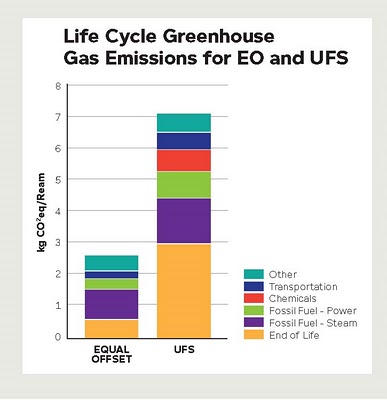Groundwood Paper Greenhouse Gas Footprint Much Lower Than Freesheet Paper
-----------------
Uncoated groundwood paper (such as newsprint, are made from mechanically ground wood pulp that contains impurities - i.e., everything that nature puts into the tree) has less than half the carbon footprint of uncoated freesheet paper (which are made from pulp that is "cooked" and chemically treated to leave them free of impurities) with the same purpose, a recent study by Canadian researchers suggests.
Not only does groundwood paper use fewer trees, but it also requires virtually no harmful chemicals to make and releases far less methane -- a greenhouse gas – when landfilled, the two Université de Montréal researchers found.
The researchers conducted a “cradle-to-grave” environmental assessment of AbitibiBowater’s Equal Offset groundwood paper in comparison with similar-quality uncoated freesheet (UFS) papers made at mills in Quebec and the U.S. South. None of the products studied contained recycled content.
The research report and accompanying fact sheet said that life cycle assessments of Abitibi’s other UFS-substitute products would probably yield similar results as Equal Offset. Abitibi markets the products as a lower-cost replacement for freesheet papers in such uses as direct mail and books.
Abitibi commissioned the independent, peer-reviewed research. Abitibi’s involvement may lead to charges of bias, but the notion that papers made with mechanical pulp are greener than those made with kraft pulp is not exactly a novel concept
“It was found that Equal Offset emits only about 38% of the greenhouse gases associated with the production of UFS over its life cycle,” the report says. “EO is made with mechanical pulp, which has a high yield, and is bulkier than freesheet made from chemical pulp, thus using fewer trees for the same area of paper.”
Methane Gas Emissions
The researchers calculated that more than 40% of UFS’ carbon footprint fell into the “End of Life” category, mostly from the release of methane as the paper degrades in landfills. (Yes, paper can be recycled, but there’s a limit to how many times wood-derived fibers can be recycled before they become unusable and end up in the waste stream.) UFS’ End of Life greenhouse-gas emissions were about seven times that of Equal Offset, they said.
“According to studies of methane generation in anaerobic landfills reported in the literature, products made of mechanical pulp, such as newsprint, degrade much less than office paper made of chemical pulps. This is thought to be due to non-reactivity of lignin in the decomposition reactions, as well as ‘protection’ of some of the cellulose. Further analysis by the US EPA estimates that 85% of the carbon in newsprint remains intact, compared to only 12% in office paper,” the report says.
The study looked at 15 different “environmental impact parameters”, not just carbon footprint. “The study considered a full range of inputs and outputs throughout the product life cycle, and the results were compelling” – Equal Offset’s impact was lower in 14 of the 15 categories, dramatically lower in some cases.
The UFS products used chemicals like sulfur and sulfuric acid in the pulping and bleaching process, as well as more starch (requiring farmland for growing potatoes and corn), according to the report. They also consumed more fossil fuel, partly because the Alma, Quebec mill that makes Equal Offset uses 95% hydro-electric power.
If the researchers’ conclusions are accurate and applicable to paper products in general, they suggest that a 100%-virgin groundwood paper is more environmentally friendly than a freesheet with 30% post-consumer waste – assuming no significant differences in the forestry practices that generated the virgin fiber.
And they confirm that the $8 billion or so that the U.S. government shelled out in black-liquor credits last year from a green-energy program actually did environmental damage not only by discouraging the use of recycled fiber but also by subsidizing freesheet products at the expense of groundwood.
For more articles about the difference between papers made with kraft pulp (freesheet) and those made with mechanical pulp (groundwood), please see:
- Pulp Fiction: Eco-Credits for Black Liquor: "Mechanical pulp is usually considered environmentally preferable to kraft because it uses fewer trees and causes less pollution."
- The Yellowing of National Geographic: Will Today's Copies Age Faster Than That Stack in Your Gramma's Attic? A disadvantage of groundwood papers is that they degrade faster than those containing only kraft pulp
---------------

